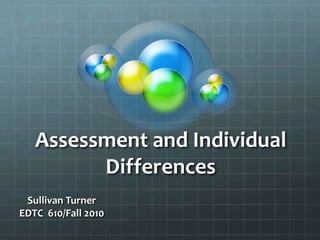Assessment and individual differences
•Download as PPTX, PDF•
2 likes•1,038 views
Report
Share
Report
Share

Recommended
Recommended
More Related Content
What's hot
What's hot (20)
Lev vygotsky and his work on cognitive development

Lev vygotsky and his work on cognitive development
Emotional and Behavioral Disorders (EBD) and Grade I Pupils' Achievements

Emotional and Behavioral Disorders (EBD) and Grade I Pupils' Achievements
Traditional assessment and non traditional assessment

Traditional assessment and non traditional assessment
LESSON 2 Learner-Centered Psychological Principles.pptx

LESSON 2 Learner-Centered Psychological Principles.pptx
Similar to Assessment and individual differences
Similar to Assessment and individual differences (20)
DEVELOPMENT AND EVALUATION OF SCALES/INSTRUMENTS IN PSYCHIATRY

DEVELOPMENT AND EVALUATION OF SCALES/INSTRUMENTS IN PSYCHIATRY
2.3. Types of Validity in assessment and education

2.3. Types of Validity in assessment and education
Recently uploaded
Recently uploaded (20)
Unit-IV; Professional Sales Representative (PSR).pptx

Unit-IV; Professional Sales Representative (PSR).pptx
Mixin Classes in Odoo 17 How to Extend Models Using Mixin Classes

Mixin Classes in Odoo 17 How to Extend Models Using Mixin Classes
Measures of Central Tendency: Mean, Median and Mode

Measures of Central Tendency: Mean, Median and Mode
Russian Escort Service in Delhi 11k Hotel Foreigner Russian Call Girls in Delhi

Russian Escort Service in Delhi 11k Hotel Foreigner Russian Call Girls in Delhi
Z Score,T Score, Percential Rank and Box Plot Graph

Z Score,T Score, Percential Rank and Box Plot Graph
ICT Role in 21st Century Education & its Challenges.pptx

ICT Role in 21st Century Education & its Challenges.pptx
Python Notes for mca i year students osmania university.docx

Python Notes for mca i year students osmania university.docx
Food Chain and Food Web (Ecosystem) EVS, B. Pharmacy 1st Year, Sem-II

Food Chain and Food Web (Ecosystem) EVS, B. Pharmacy 1st Year, Sem-II
Beyond the EU: DORA and NIS 2 Directive's Global Impact

Beyond the EU: DORA and NIS 2 Directive's Global Impact
Seal of Good Local Governance (SGLG) 2024Final.pptx

Seal of Good Local Governance (SGLG) 2024Final.pptx
Ecological Succession. ( ECOSYSTEM, B. Pharmacy, 1st Year, Sem-II, Environmen...

Ecological Succession. ( ECOSYSTEM, B. Pharmacy, 1st Year, Sem-II, Environmen...
Assessment and individual differences
- 1. Assessment and Individual Differences Sullivan Turner EDTC 610/Fall 2010
- 2. Psychometric Model Assumes that personal traits, including knowledge and cognitive abilities can be measured by weight and distance Has tremendous power to influence life decisions Classify children as gifted, learning disabled, or emotionally disturbed based on test performance
- 3. Reliability Replicability of a test score True Scores and Observed Scores • Perfect reliability is impossible • Measurement Error • True Score • Observed scores Observed Score = True Score ± Measurement Error
- 4. Reliability Confidence Interval • True scores will be within the confidence level with a known level of probability Number of Items • High reliability is desirable • Increase number of questions to boost test reliability
- 5. Validity Is concerned with the meaning of what is measured A completely valid test measures fully and accurately what it is intended to measure
- 6. Validity What Does the Score Mean? • Construct Validity: concerned with whether a test measures what it is intended to measure.
- 7. Validity What Does the Score Mean? • Concurrent Validity: evidence that a test measures a distinct construct within a theoretical system. • Predictive Validity: predicts test performance
- 8. Validity Construct Under – Representation • Means a test falls short of representing all that is intended to construct Construct Over – Representation • Whenever a test measures something other than the construct that it is intended to measure.
- 9. Validity Construct Over – Representation • Measurement Contamination • Response - elimination strategy • Testwiseness • Test anxiety
- 10. Validity Measurement Variance: Variation in test scores among examinees can be expressed quantitatively s2 = Σ (X – X)2 n–1
- 11. Validity Measurement Variance • Construct – Irrelevant Variance • Every test is contaminated • Response eliminated strategy used in multiple choice testing
- 12. How Test Influence Learning Washback Effects: Anticipation of test consequences can feed back to influence the processes of learning and teaching that lead up to the test. • Teaching to the Test Measurement Driven Instruction • Minimal Competency testing • Consequential validity
- 13. Performance Assessment Assessment • Asking for complex responses/diagnostic information Performance Assessments • Educational value “teaching to the test” Authentic Assessments • Leads to products and outcomes with intrinsic value
- 14. Classroom Assessment Everyday Assumptions of Testing Designing Tests • Multiple – Choice Question • Constructed Response Items 1. Scoring rubrics 2. Holistic scoring 3. Analytical scoring
- 15. Formative Assessment Summative Assessment • Summarize the effects of past educational experience Formative Assessment • Guide and match ongoing teaching and learning experiences Assessment of Learning • Promotes student learning
- 16. Standardized Testing Raw score • Point value given on a particular test Normal Distribution • Mean • Mode • Standard Deviation Standard Scores • Percentile rank
- 17. Quantitative Research Qualitative Research • Emphasize detailed description rather than numerical measurement Quantitative Research • Emphasizes numerical measurements of constructs Descriptive Analysis • States factual information
- 18. Attitude Interactions: ATIs Common intuition that different students learn under different conditions. Aptitude • General cognitive ability Treatment • Identifiable educational experience Interaction • Matching treatment to aptitude
- 19. Diversification of Instruction Cognitive Styles • Field dependence vs field independence • Impulsivity vs reflectivity Learning Styles • Multiple Intelligences (MI) theory • Time and Learning • Mastery Learning
- 20. Group Differences Gender Differences Socioeconomic Differences Racial – Ethnic Differences • The Achievement Gap • Test Bias
- 21. Learning Strategies Increase the number of test items Use a full representation of the construct Widen the process dimension of test design Use a variety of testing formats Use performance assessment
- 22. Learning Strategies Be cautious about learning styles Consider aptitude- treatment interactions Give learning sufficient time Guard against test bias Close the achievement gap